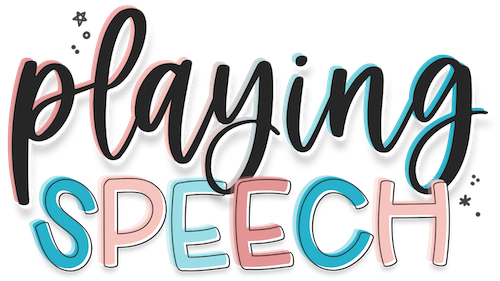Using the Complexity Approach in Speech Therapy? What You Need to Know!
Complexity Approach for Speech Therapy Overview
Using the concept of complexity and/or a “complexity approach” in my speech therapy activities has been a GAME changer with my students with moderate-severe phonological disorders.
What’s the rationale for using more complex, later developing sounds as targets in your speech therapy sessions? The basic idea is that by targeting more complex or “marked” sound classes (like clusters or affricates) then less complex or “unmarked” sound classes (like fricatives or stops) are also likely to be acquired indirectly!
The speech language pathologist can help facilitate greater system-wide change in the child’s phonological system FASTER! You basically get more progress in less time while also working on fewer sounds directly! Sounds like a dream, right?
So let’s discuss how you choose targets when using a complexity approach in your speech therapy sessions.
Choosing Complex Speech Sound Targets
So how do you choose complex targets for your children with phonological disorders? Well, it could be slightly different for every child. Generally you want to consider 4 things: (1) sounds the child has least productive phonological knowledge of, (2) nonstimulable phonemes, (3) later acquired phonemes, and (4) marked phonemes and clusters.
I am going to break down what each one of these things means.
Least productive phonological knowledge simply means sounds that the child doesn’t produce at all, sounds that are not in his system currently. The theory is that by choosing sounds that the child does not use yet on his own, you will affect greater change on the entire phonological system, more so than if you had targeted a sound he somewhat “knows” already. (There is a continuum of phonological knowledge, but that’s for another post).
Nonstimulable phonemes means just that. Don’t choose targets the child is easily stimuable for. Choose the ones you have to work for. Again, the theory is that if the child is stimulable for a sound, he already has some “knowledge” of this sound and it is not likely to create as much change in his phonological system if you target it.
Later acquired phonemes means choosing the sounds that typically develop later in a child’s speech system. So, for example, if you have a choice between B and SH, go with the SH sound as that sound typically develops after the B sound. The reasoning for this is that by definition, later developing sounds are more complex than early acquired sounds.
Markedness is based on implication rules for languages. There are language universals (or rules) that help determine which sounds are considered more complex. For example, if a language has affricates, then it has to also have fricatives. But if a language has fricatives, it does not necessarily mean that that language contains affricates. Therefore, affricates are considered more complex than fricatives. The theory is, if we choose more complex, marked sounds, then we can facilitate learning of less complex, unmarked sounds without having to directly target them in therapy. So if the child is missing affricates, fricatives, and stops in his inventory, consider targeting affricates to get greater system-wide change faster.
These 4 elements will interact different within each child and will lead to very individualized target selection.
Let’s Talk About Complex Clusters
Clusters are the most complex elements of the English language, with clusters being more complex than singletons and 3-element clusters being more complex than 2-element clusters.
When using clusters in a speech therapy complexity approach, there are certain caveats and guidelines you must consider.
Regarding 3-element clusters, you can’t just willy-nilly pick any old clusters. The child must have the second and third consonants in their repertoire in order to get the most out of this intervention. This info comes from Gierut and Champion (2001).
They saw that children who had the /s/ and stop of a 3 element cluster (like SPL) in their phonemic inventory only demonstrated learning of untaught two-element adjunct clusters (SP, SK, ST) and nothing else.
But children who had the stop and glide or liquid of a three-element cluster (like SPL) in their phonemic inventory showed learning of untaught two-element true clusters and singletons!
And children who only knew one element of the three-element cluster did not show generalization to any two element clusters (neither adjunct nor true clusters).
Regarding 2-element clusters, you should choose clusters with a small sonority difference. Why? Because children who were taught clusters with a small sonority difference (e.g. +3) generalized their learning to other clusters at a variety of sonority differences. Children who were taught clusters with a large sonority difference only learned the treated clusters and showed narrow generalization
Need MORE Information About Complex Clusters??
I created a resource all about using complex clusters in speech therapy when treating phonological disorders. It includes some quick start info and handouts as well as over 100 stimuli cards for the 10 most complex 2- and 3-element clusters in the English language. I also included 50 no prep worksheets to use in your sessions or send home for homework AND Boom Card complex clusters stimuli…because I am all about that no prep, no print, grab-and-go speech therapy! It has everything you need to get started using complex clusters in your speech therapy sessions today! Check out the resource by clicking here.
So That’s All About The Complexity Approach for Speech Therapy.
Please send me a comment or an email if you have any questions! I love chatting all things SSD. And check me out on Instagram @playingspeech. I am always sharing information regarding speech sound disorders!
SOURCES:
Gierut, J. and Champion, A. (2001) Syllable onsets II: three-element clusters in phonological treatment. Journal of speech, language, and hearing research, 44(4), 886–904.
Storkel, H.L. (2018) The Complexity Approach to Phonological Treatment: How to Select Treatment Targets. Language, Speech, and Hearing Services in Schools, 1–19:






